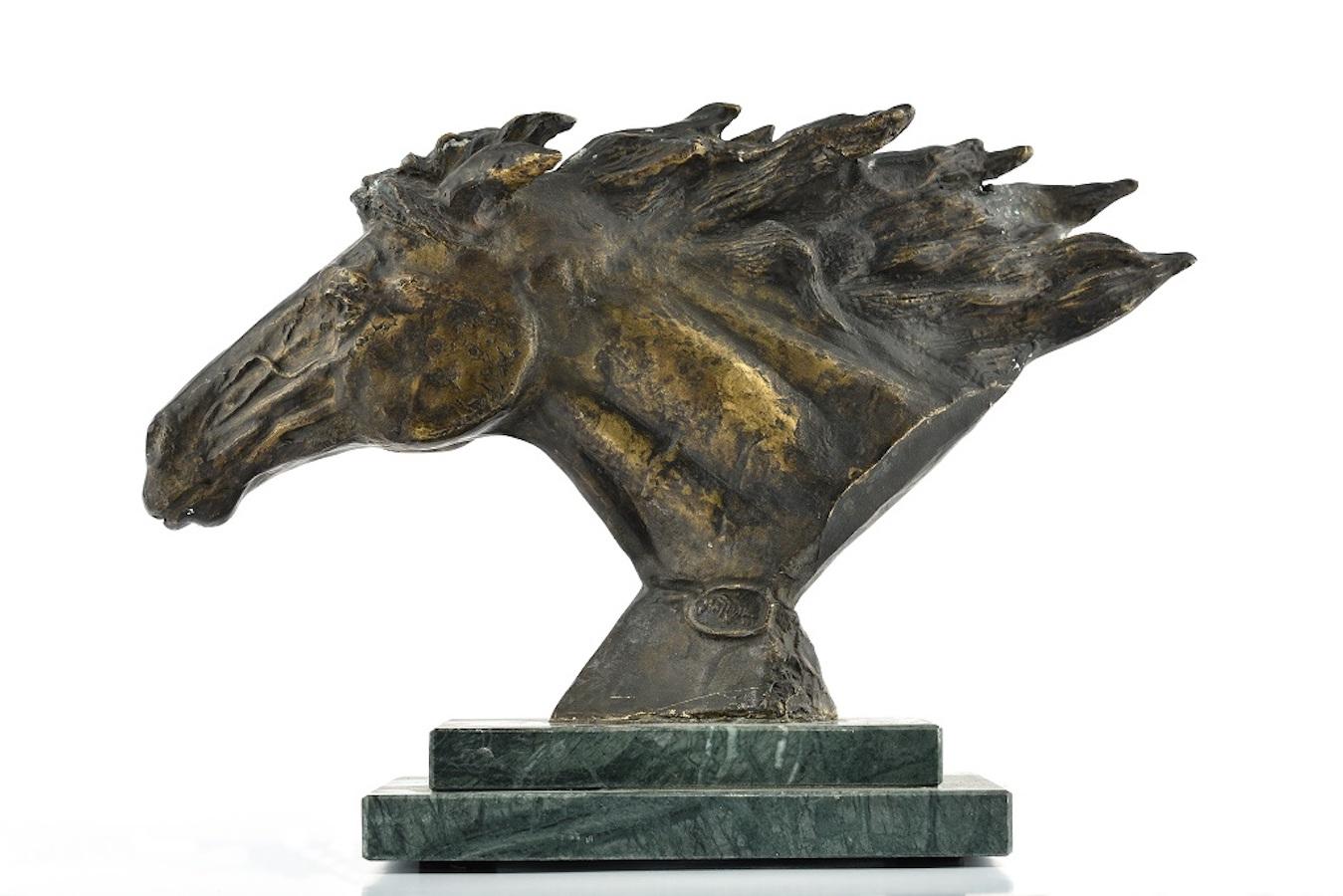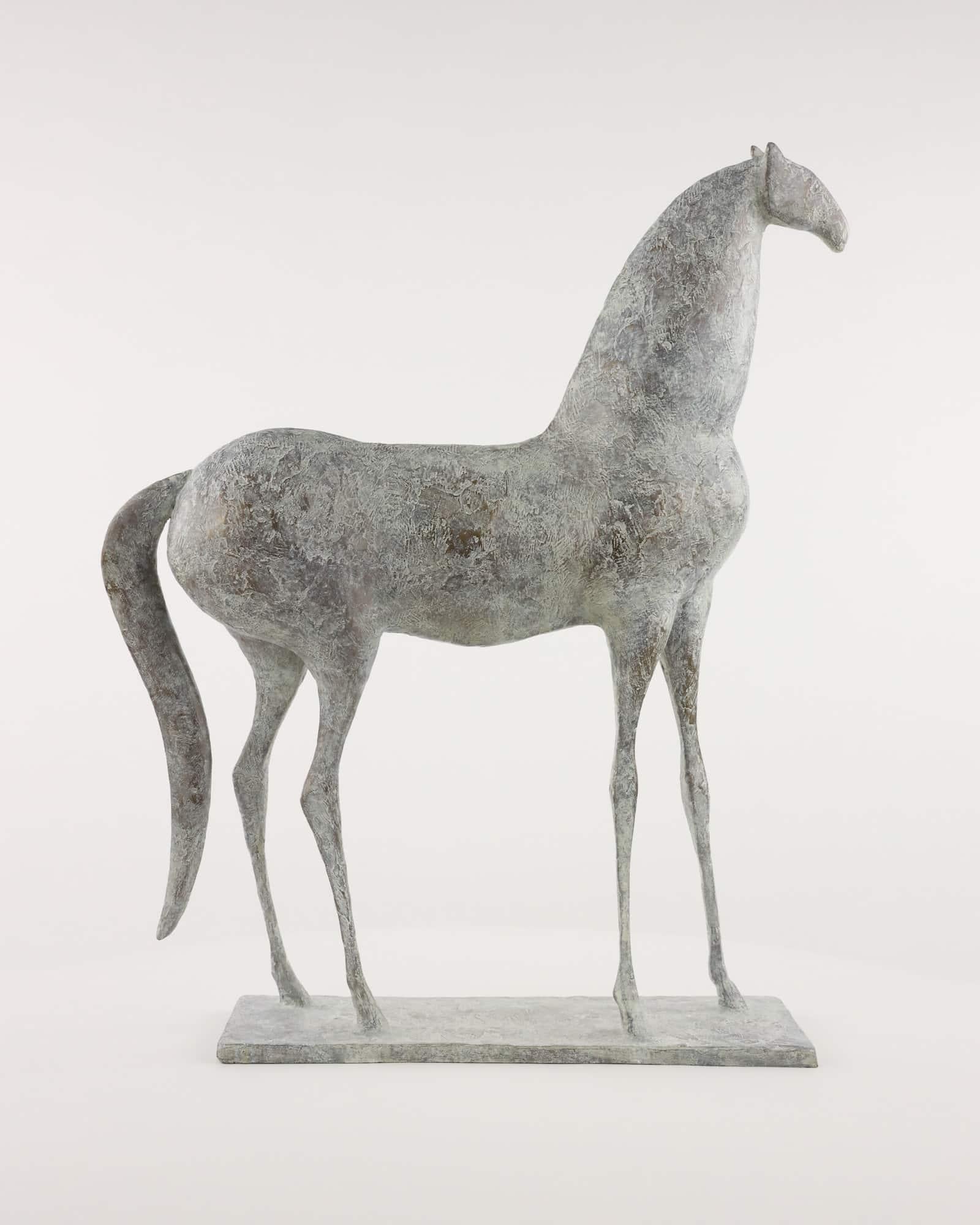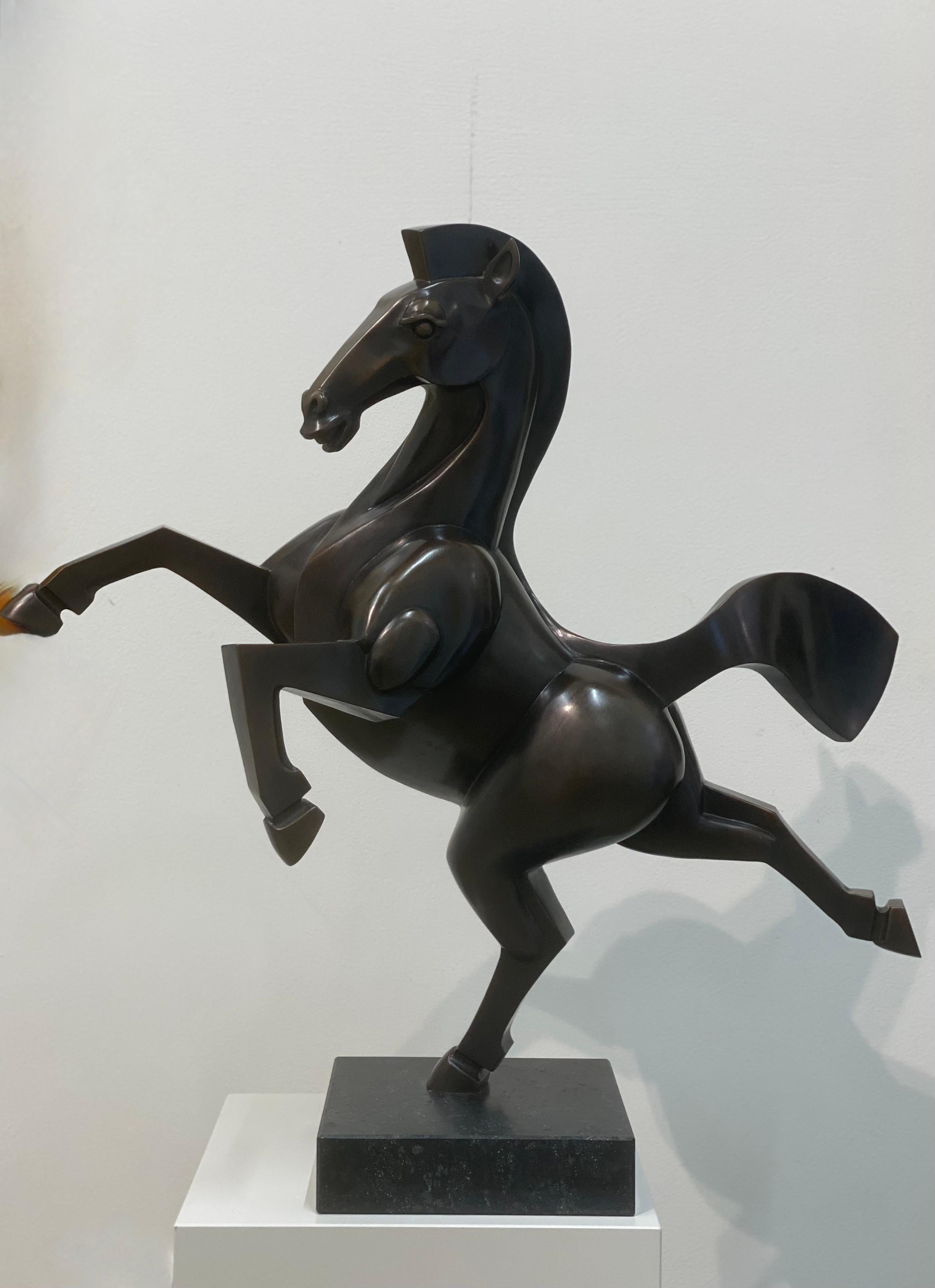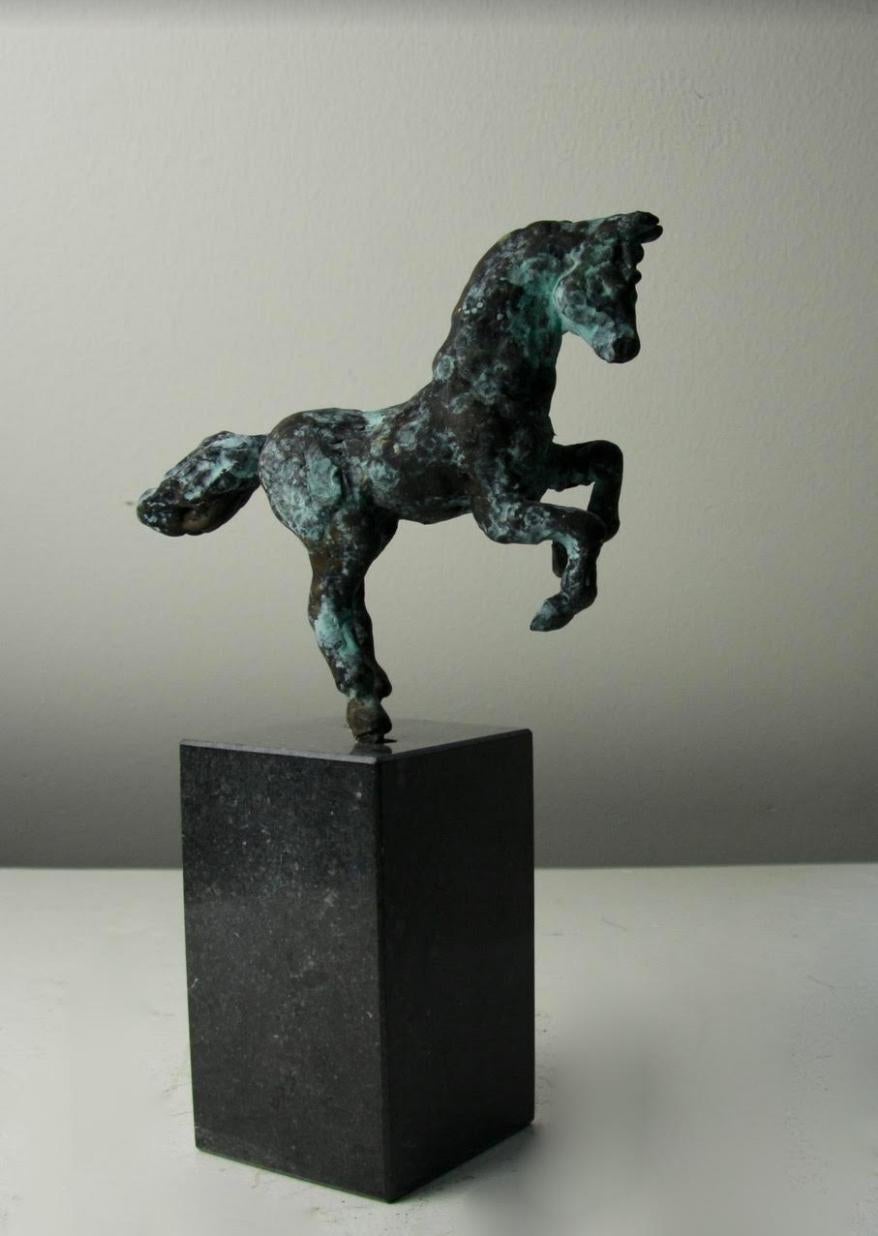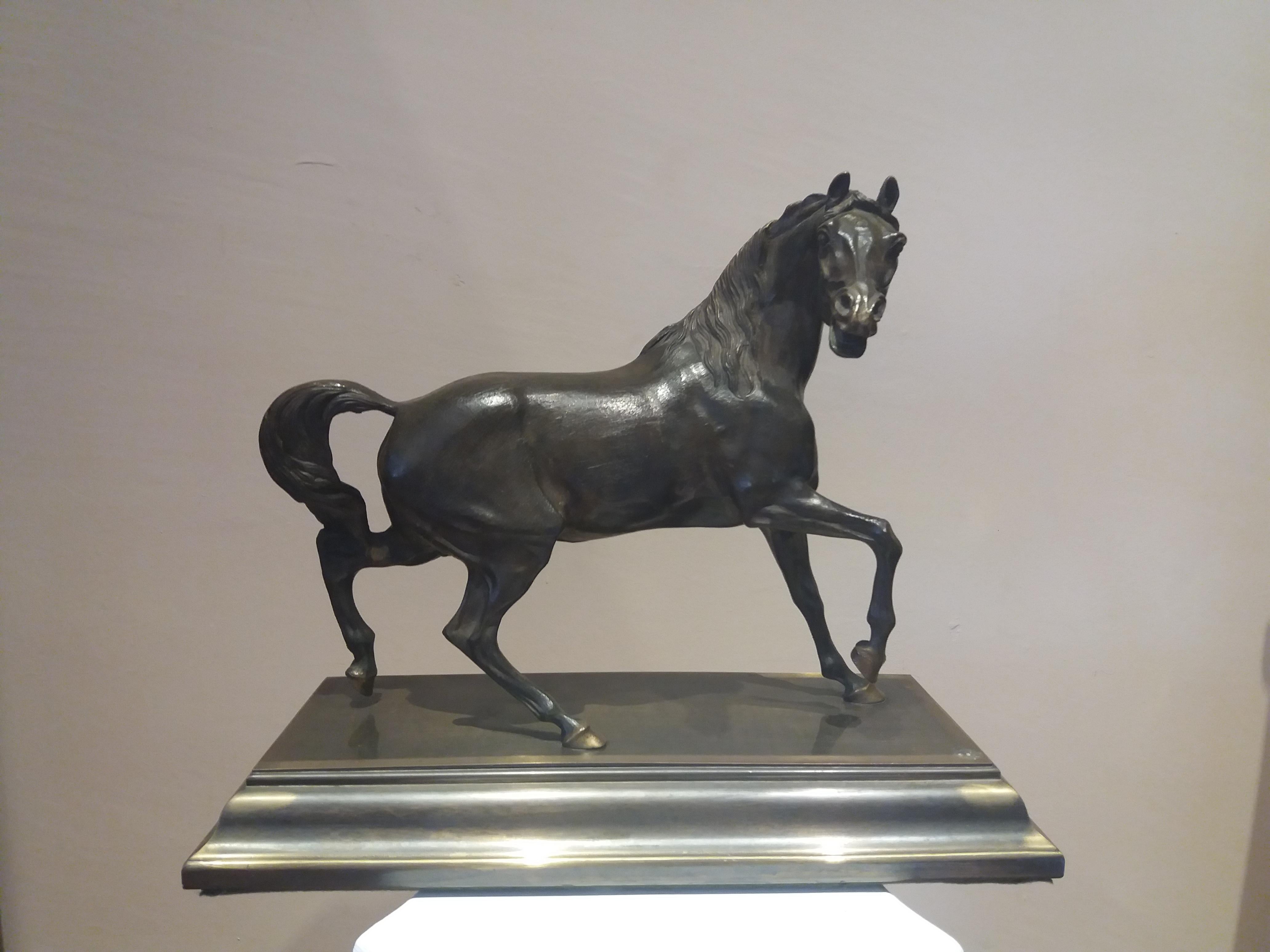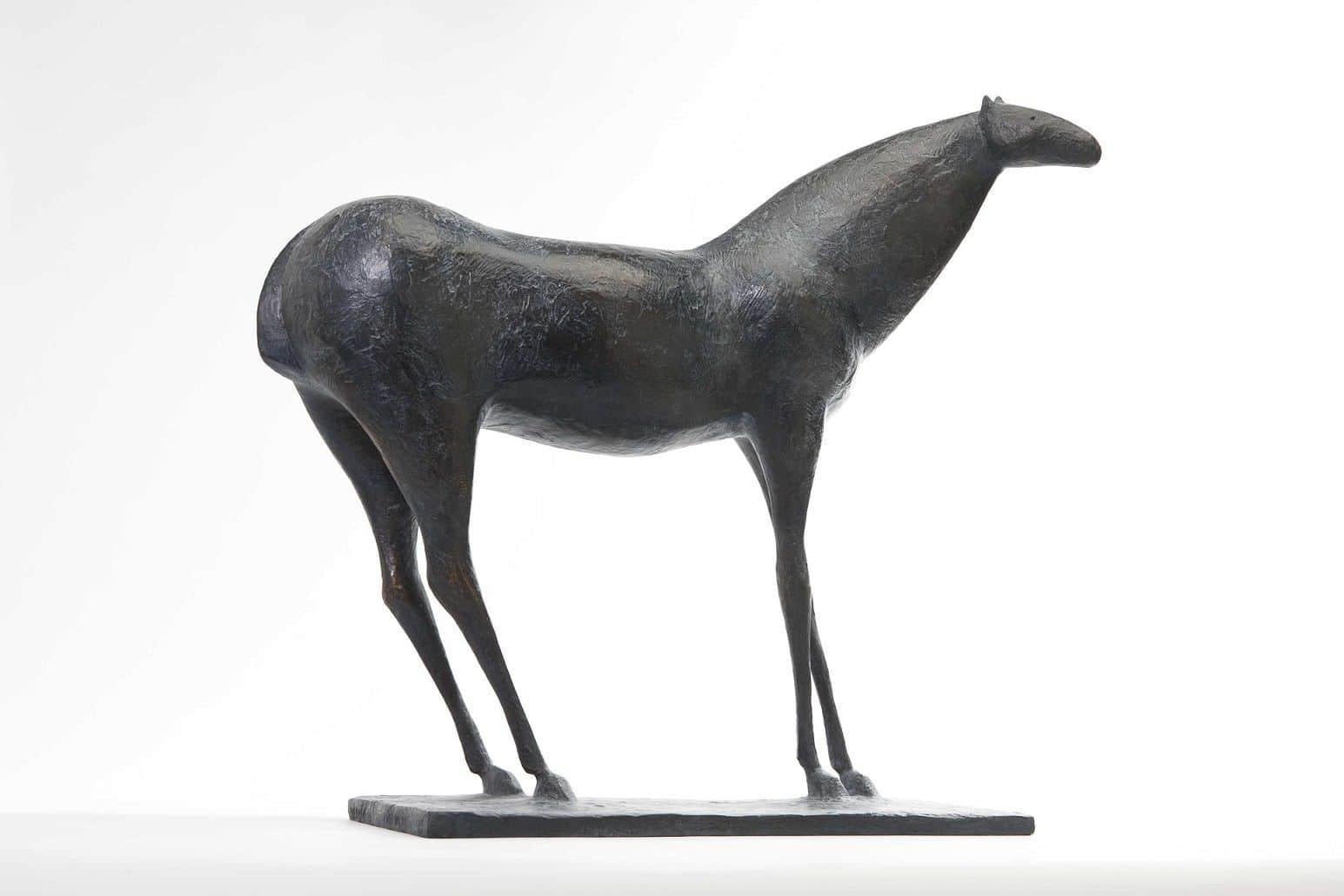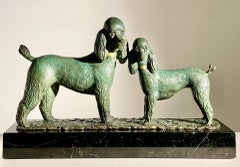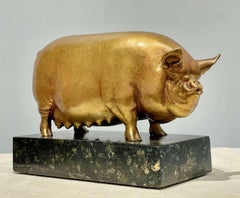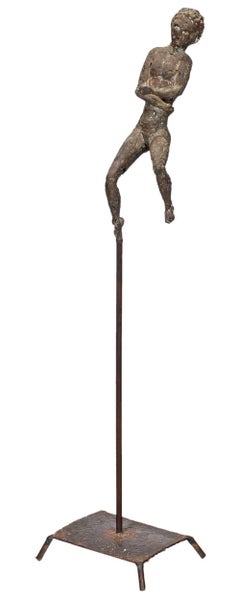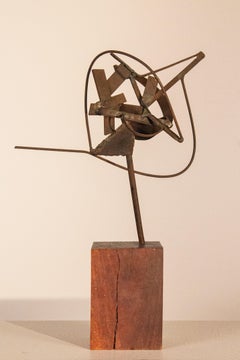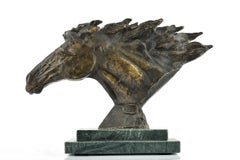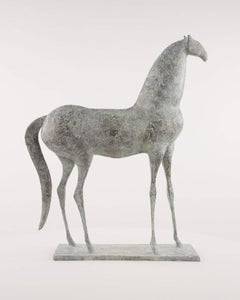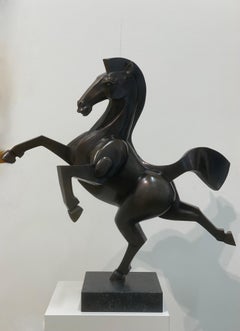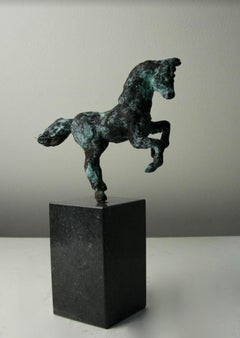Items Similar to "Sudbourne Premier: Suffolk Punch Stallion" Herbert Haseltine, 1927 Bronze
Want more images or videos?
Request additional images or videos from the seller
1 of 6
Herbert Haseltine"Sudbourne Premier: Suffolk Punch Stallion" Herbert Haseltine, 1927 Bronze1927
1927
$35,000
£26,448.35
€30,541.35
CA$48,907.22
A$54,266.68
CHF 28,426.05
MX$665,455.14
NOK 361,569.60
SEK 341,306.28
DKK 227,766
Shipping
Retrieving quote...The 1stDibs Promise:
Authenticity Guarantee,
Money-Back Guarantee,
24-Hour Cancellation
About the Item
Herbert Haseltine
Sudbourne Premier: Suffolk Punch Stallion, 1927
Signed left side: © HASELTINE / MCMXXVII
Bronze, dark brown patina, parcel gilding
10 1/2 inches high. x 11 1/2 inches wide x 6 1/2 inches deep
Mounted atop two-tier burgundy marble base, 5 ¾ H. inches
Overall height: 13 ¾ inches
Born in Rome, then still Lazio and not part of Italy as such, the son of the wealthy American landscape painter William Stanley Haseltine (1835–1900) who was associated with the Hudson River School and Luminism, he studied at Harvard University. After graduating in 1899, Haseltine went to Munich Academy in Germany to study drawing and then to the Académie Julian in Paris, France where he studied painting.
After his first piece of sculpture met with success, he pursued that artistic avenue. Inspired by the gathering of artists from around the world to the Montparnasse Quarter of Paris, Haseltine chose to make Paris his home for the next thirty-five years until the German occupation of France during World War II. He moved to the United States where he remained until 1947 at which time he returned to France.
Equestrian statue of Sir John Dill statue at Arlington National Cemetery by Haseltine.
In 1940 he was elected into the National Academy of Design as an Associate member and became a full Academician in 1946.
Haseltine sculpted a variety of animals but is best known for his equestrian sculptures, most notably the 1934 life-size statue of the thoroughbred race horse Man o’ War at the Kentucky Horse Park in Lexington, Kentucky and “George Washington on Horseback”, Gilded bronze statue at the Washington National Cathedral made in 1959. He also traveled to India, where he made an oversized statue of one of the ancestors of the Maharaja of Nawanagar, Jam Shri Rawalji in 1933. It can still be seen there. He replicated many of his large works in table-top sizes. The author of a number of books on animalier art, Haseltine was well connected in American upper class society and did a three-year project to create a work for heiress Barbara Hutton. This project included two horses heads which were gilded bronze, with precious and semi precious stones. After her death the heads disappeared and resurfaced a few years ago at an auction in New York.
- Creator:Herbert Haseltine (1877 - 1962, American, French, Italian)
- Creation Year:1927
- Dimensions:Height: 10.5 in (26.67 cm)Width: 11.5 in (29.21 cm)Depth: 6.5 in (16.51 cm)
- Medium:
- Movement & Style:
- Period:
- Condition:
- Gallery Location:New York, NY
- Reference Number:1stDibs: LU1841214835412
About the Seller
5.0
Platinum Seller
Premium sellers with a 4.7+ rating and 24-hour response times
Established in 2022
1stDibs seller since 2022
108 sales on 1stDibs
Typical response time: <1 hour
- ShippingRetrieving quote...Shipping from: New York, NY
- Return Policy
Authenticity Guarantee
In the unlikely event there’s an issue with an item’s authenticity, contact us within 1 year for a full refund. DetailsMoney-Back Guarantee
If your item is not as described, is damaged in transit, or does not arrive, contact us within 7 days for a full refund. Details24-Hour Cancellation
You have a 24-hour grace period in which to reconsider your purchase, with no questions asked.Vetted Professional Sellers
Our world-class sellers must adhere to strict standards for service and quality, maintaining the integrity of our listings.Price-Match Guarantee
If you find that a seller listed the same item for a lower price elsewhere, we’ll match it.Trusted Global Delivery
Our best-in-class carrier network provides specialized shipping options worldwide, including custom delivery.More From This Seller
View All"Poodles: Nora and Sheila" Herbert Haseltine, Bronze Dogs Animals Sculpture
Located in New York, NY
Herbert Haseltine
Poodles: Nora and Sheila, 1944, cast 1945
Signed and dated on base
Bronze with green patina
11 inches high x 17 inches wide x 6 inc...
Category
1940s Realist Figurative Sculptures
Materials
Bronze
"Middle White Sow (Wharfedale Royal Lady)" Herbert Haseltine, Pig, Farm Animal
Located in New York, NY
Herbert Haseltine
Middle White Sow (Wharfedale Royal Lady), 1925
Polished bronze with opaque ochre patina
4 ⅛ x 8 ⅛ x 3 ⅝ inches
Period speckled Belgian marble base: 1 ½ x 7 x 3 inch...
Category
1920s Realist Figurative Sculptures
Materials
Bronze
"Dancer" David Hare, Male Nude, Figurative Sculpture, Mid-Century Surrealist
By David Hare
Located in New York, NY
David Hare
Dancer, circa 1955
Bronze with integral stand
68 high x 17 wide x 13 1/2 deep inches
“Freedom is what we want,” David Hare boldly stated in 1965, but then he added the caveat, “and what we are most afraid of.” No one could accuse David Hare of possessing such fear. Blithely unconcerned with the critics’ judgments, Hare flitted through most of the major art developments of the mid-twentieth century in the United States. He changed mediums several times; just when his fame as a sculptor had reached its apogee about 1960, he switched over to painting. Yet he remained attached to surrealism long after it had fallen out of official favor. “I can’t change what I do in order to fit what would make me popular,” he said. “Not because of moral reasons, but just because I can’t do it; I’m not interested in it.”
Hare was born in New York City in 1917; his family was both wealthy and familiar with the world of modern art. Meredith (1870-1932), his father, was a prominent corporate attorney. His mother, Elizabeth Sage Goodwin (1878-1948) was an art collector, a financial backer of the 1913 Armory Show, and a friend of artists such as Constantin Brancusi, Walt Kuhn, and Marcel Duchamp.
In the 1920s, the entire family moved to Santa Fe, New Mexico and later to Colorado Springs, in the hope that the change in altitude and climate would help to heal Meredith’s tuberculosis. In Colorado Springs, Elizabeth founded the Fountain Valley School where David attended high school after his father died in 1932. In the western United States, Hare developed a fascination for kachina dolls and other aspects of Native American culture that would become a recurring source of inspiration in his career.
After high school, Hare briefly attended Bard College (1936-37) in Annandale-on-Hudson. At a loss as to what to do next, he parlayed his mother’s contacts into opening a commercial photography studio and began dabbling in color photography, still a rarity at the time [Kodachrome was introduced in 1935]. At age 22, Hare had his first solo exhibition at Walker Gallery in New York City; his 30 color photographs included one of President Franklin Roosevelt.
As a photographer, Hare experimented with an automatist technique called “heatage” (or “melted negatives”) in which he heated the negative in order to distort the image. Hare described them as “antagonisms of matter.” The final products were usually abstractions tending towards surrealism and similar to processes used by Man Ray, Raoul Ubac, and Wolfgang Paalen.
In 1940, Hare moved to Roxbury, CT, where he fraternized with neighboring artists such as Alexander Calder and Arshile Gorky, as well as Yves Tanguy who was married to Hare’s cousin Kay Sage, and the art dealer Julian Levy. The same year, Hare received a commission from the American Museum of Natural History to document the Pueblo Indians. He traveled to Santa Fe and, for several months, he took portrait photographs of members of the Hopi, Navajo, and Zuni tribes that were published in book form in 1941.
World War II turned Hare’s life upside down. He became a conduit in the exchange of artistic and intellectual ideas between U.S. artists and the surrealist émigrés fleeing Europe. In 1942, Hare befriended Andre Breton, the principal theorist of surrealism. When Breton wanted to publish a magazine to promote the movement in the United States, he could not serve as an editor because he was a foreign national. Instead, Breton selected Hare to edit the journal, entitled VVV [shorth for “Victory, Victory, Victory”], which ran for four issues (the second and third issues were printed as a single volume) from June 1942 to February 1944. Each edition of VVV focused on “poetry, plastic arts, anthropology, sociology, (and) psychology,” and was extensively illustrated by surrealist artists including Giorgio de Chirico, Roberto Matta, and Yves Tanguy; Max Ernst and Marcel Duchamp served as editorial advisors.
At the suggestion of Jacqueline Lamba...
Category
1950s Abstract Figurative Sculptures
Materials
Bronze
$20,000 Sale Price
20% Off
"Untitled" Sidney Gordin, Abstract Metal Steel Sculpture
By Sidney Gordin
Located in New York, NY
Sidney Gordin
Untitled, 1958
Incised with initials
Welded Steel
15 x 10 1/2 x 6 inches
Provenance:
Eric Firestone Gallery, New York
On October 24, 1918, Sidney Gordin was born in Chelyabinsk, Russia. He spent his early years in Shanghai, China. At the age of four, he moved with his family to New York. Gordin’s nephew, Eliot Nemzer recalls that when Gordin was a child he attended “a dinner party with his parents. Someone showed him a book of pictures that when thumbed through quickly made the image appear to move. This person then gave him a wad of blank papers and something to write with. Sid created a similar type of moving image with his materials. All the adults at the party became quite excited [and] praised his efforts. Sid told me he thought this was a pivotal experience in guiding him towards his vocation.” During his formative years at Brooklyn Technical High School, he briefly contemplated the idea of becoming an architect; yet, by the time he enrolled at Cooper Union, he was determined to become a professional artist. There, he studied under Morris Kantor (1896-1974) and Leo Katz...
Category
1950s Abstract Abstract Sculptures
Materials
Steel
$11,200 Sale Price
20% Off
"Roland, " George Sugarman, Abstract Steel Sculpture
By George Sugarman
Located in New York, NY
George Sugarman (1912 - 1999)
Roland, 1970
Patinated steel
17 3/8 x 16 x 5 1/4 inches
Incised with the artist's signature and numbered "15/17" on the underside
Manufactured by Lippin...
Category
1970s Abstract Abstract Sculptures
Materials
Steel
"Young Woman Nude" Warren Wheelock, Art Deco, Modernist Female Sculpture Form
By Warren Wheelock
Located in New York, NY
Warren Wheelock
Untitled (Young Woman Nude), 1924
Incised signature and date to edge of base "© 1924 by Warren Wheelock"
Bronze
Sculpture: 20 h × 4½ w...
Category
1920s Art Deco Figurative Sculptures
Materials
Bronze
You May Also Like
Bust of a Horse - Original Bronze Sculpture by D. Mazzone - 1990s
By Domenico Mazzone
Located in Roma, IT
This Horse Bust - Sculpture is an original artwork realized by the Italian artist Domenico Mazzone (Rutigliano, Bari, 1927-1999) during the 20th century.
Lost wax bronze sculpture m...
Category
1990s Figurative Sculptures
Materials
Bronze
Horse XV by Pierre Yermia - Animal bronze sculpture, elegant, light patina, wild
By Pierre Yermia
Located in Paris, FR
Horse XV is a bronze sculpture by French contemporary artist Pierre Yermia, dimensions are 71 × 60 × 17 cm (28 × 23.6 × 6.7 in).
The sculpture is signed and numbered, it is part of ...
Category
2010s Contemporary Figurative Sculptures
Materials
Bronze
Wild Horse - 21st Century Contemporary Bronze Sculpture of a Horse
By Frans van Straaten
Located in Nuenen, Noord Brabant
Frans van Straaten
Wilde Horse VII
Bronze on bluestone pedestal
H 65 cm W 65 cm D 35 cm
Dutch artist Frans van Straaten (1963) should be called an artist of balance always searching for harmony between force and movement in combination with space. Because of the wide range in his art-education he has mastered the art of drawing, painting and sculpting technology. However, the classical plastic art of sculpture and modelling opens up the possibility for him to create his own language of sculpture in answer to his urge for art. Due to this style of sculpting, the preference for bronze is natural.
After his study of sculpture at the Academy of Art in Rotterdam (1988), Frans van Straaten creates bronze sculptures in which he unites force and movement. Feeling and Emotion converted into Matter Sculpture is an experience of space combined with the challenge of the three-dimensional. The tension of space and movement are the themes, which Frans expresses in his sculptures. Summary it can be said that the power of life and being, the feeling and emotion by force and movement will be converted into matter. The experience of space is being expressed in the shapes and characters in each of Frans’ sculptures. His sculptures of bulls express explosive power while the horses find their strength in being elegant. Each sculpture recalls this way their own association and serves as a metaphor for a certain emotion. Feelings, which has inspired the artist for each sculpture.
Powerful and Elegant Looking at the works of this artist, it becomes very clear that one of his most important sources is his background in art history. The Renaissance period as well as several Italian artists served as inspiration to Frans as a sculpture. For instance the expressions in Leonardo da Vinci’s artworks, and also Giovanni...
Category
2010s Contemporary Figurative Sculptures
Materials
Bronze
Davinci's Horse Rears by Helle Crawford, Bronze sculpture of a horse
By Helle Rask Crawford
Located in DE
Bronze sculpture of a horse that rears on granite base
Category
21st Century and Contemporary Contemporary Figurative Sculptures
Materials
Granite, Bronze
horse. 19th century bronze sculpture
Located in CORAL GABLES - MIAMI, FL
horse. 19th century bronze sculpture
measurements with the base are 37.5 x 17.5 x 31 cm
Category
Late 19th Century Art Nouveau Figurative Sculptures
Materials
Bronze
Horse XII by Pierre Yermia - Animal bronze sculpture, elegance, wild, force
By Pierre Yermia
Located in Paris, FR
Horse XII is a bronze sculpture by French contemporary artist Pierre Yermia, dimensions are 48 × 53 × 25 cm (18.9 × 20.9 × 9.8 in).
The sculpture is signed and numbered, it is part ...
Category
Early 2000s Contemporary Figurative Sculptures
Materials
Bronze
More Ways To Browse
Bronze Table Top Sculpture
Bronze Sculpture India
Bronze Statue Of Man
Antique Italian Bronze Statue
Burgundy Marble
Large Bronze Horse Sculpture
1900 Bronze Statue
Bronze Horse Head
Gold Horse Statue
Bronze Horse Table
Stanley Antique
Equestrian Table
Horse Head Table
Antique Marble Auctions
2 Tier Table Antique
2 Tiered Antique Table
Antique 2 Tier Table
Bronze Statue Germany
